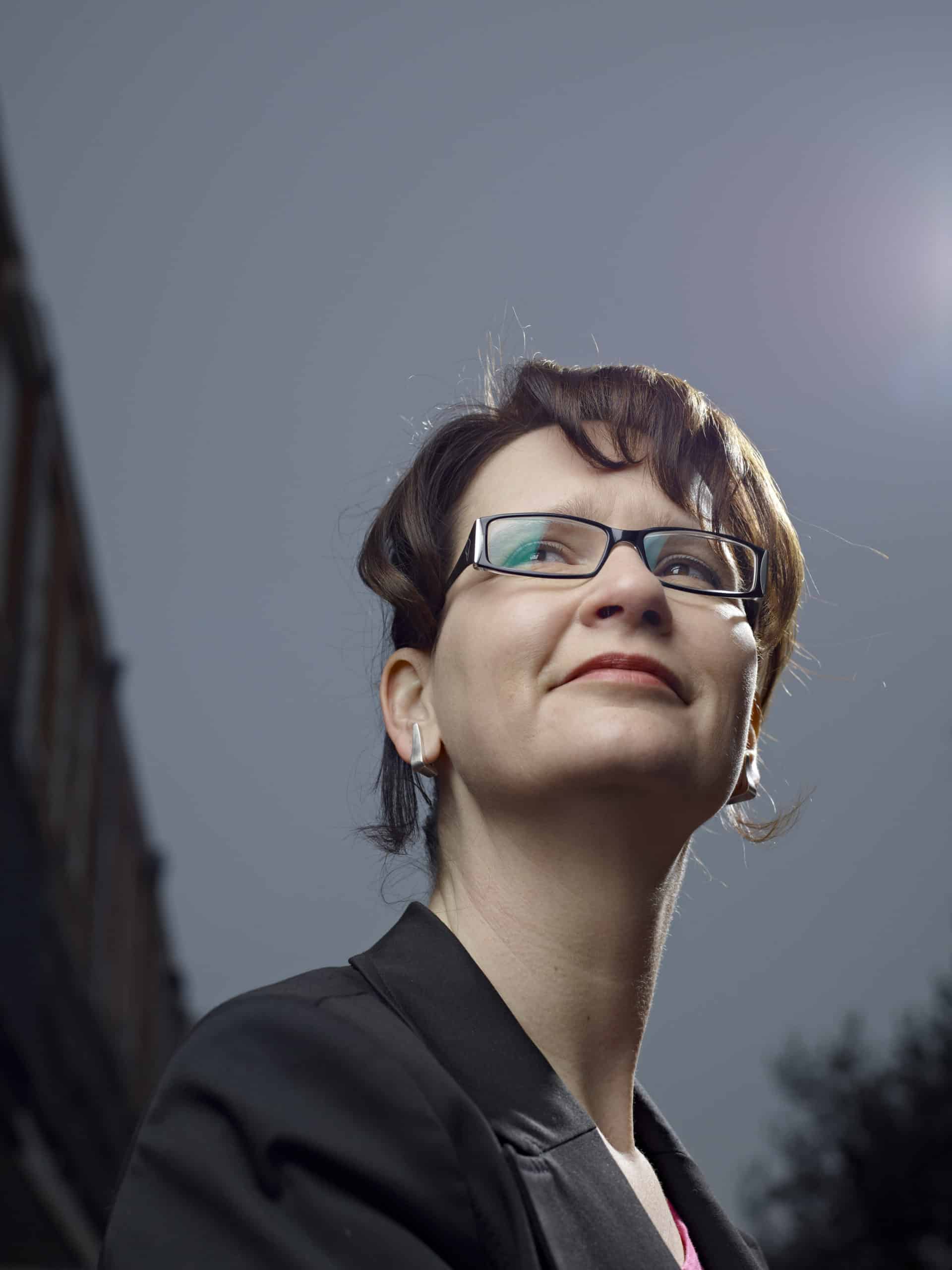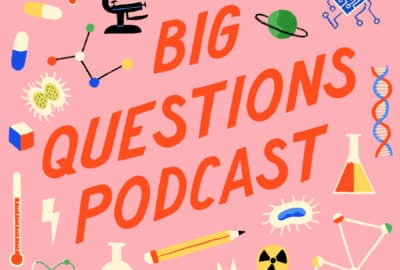Umm…Should I be wearing a mask?
Wednesday 24th Nov 2021, 12.30pm
In the early days of the COVID-19 pandemic there was a lot of confusion, as we all tried to figure out what we should and shouldn’t do to best protect ourselves and others. Fortunately, we now have more definitive answers to some of our most pressing questions – which are backed-up by data – including “umm…should I be wearing a mask?”. As COVID cases are again on the rise across Europe, this is the question we’re putting to demographer and behavioural scientist Prof Melinda Mills.
Music credit: Black Bear Kolo by Black Bear Combo
Emily Elias: We’ve been in this pandemic for a while now. In the early days, we were all scratching our heads and trying to figure out what we should and shouldn’t do, but these days there are some more definitive answers that are, thankfully, backed up with research. As COVID cases are on the rise across Europe, on this episode of the Oxford Sparks Big Questions Podcast, we are asking, “Umm, should I be wearing a mask?”
Hello, I’m Emily Elias, and this is the show where we seek out the brightest minds at the University of Oxford and we ask them the big questions. For this one, we found a fellow Canadian and researcher with a lot of mask facts.
Melinda Mills: My name is Melinda Mills, and I’m the Director of the Leverhulme Centre for Demographic Science at the University of Oxford, in Nuffield College. Yes, I’m a professor of demography, but I also serve on various COVID committees, such as for the Government Office of Science, for the SAGE Committee, and also for the European Commission, on coming out of COVID.
Emily: Okay, so we’ve been living in this pando for a while. What’s the case for people wearing a mask when they are out and about?
Melinda: Face coverings or masks, it’s very clear now that they’ll reduce transmission through all sorts of routes. They’ll reduce transmission if you cough, or if you talk, or if you shout, (Laughter) but they’ll also protect you as well from others, to a lesser extent.
We realise now, during the pandemic, that there was originally this focus on hand washing and cleaning surfaces, but it became very clear that it was aerosol and droplets that carry the virus. It was dependent on how close you were to others, so a mask is one of those many measures, but it’s a very effective one to stop the transmission but to also protect you, as well.
Emily: How is the data backed up that wearing a mask is the way to go?
Melinda: I think, amongst the public, that’s where the issue has been very unclear because you might remember, very early on in early 2020, on April 6th, the WHO actually said, “Wait. Healthy people don’t need to wear a mask.” On April 8th, the European Centre for Disease Control – this is in 2020, remember – said that there was no evidence.
In England they were also saying, “There’s no conclusive evidence that face coverings protect you or others,” but then, at the same time in the US, in early April as well, 2020, the Centre for Disease Control recommended wearing face masks. They thought it was very clear that this was aerosol transmitted.
Then, on June 5th, all of a sudden the WHO did a U-turn and updated their guidance, recommending that the public should wear face masks. So, after June 5th 2020, a lot of changes happened. Many Asian countries that had already experienced previous pandemics already knew about the effectiveness of face masks, so they had long been wearing them. They didn’t have to make them mandatory. They didn’t even have to have a public discussion. People just wore them because they knew that they worked.
I think that data has changed over time. Now, more recently, it has been very clear in 2021 there’s a huge body of evidence now that demonstrates the effectiveness of face coverings, that they reduce transmission, through all sorts of routes, in reducing the spread of the virus. They, to a lesser extent, protect the wearer, but it’s really quite clear. We’ve had randomised controlled trials in Bangladesh. We’ve had multiple things that show that they’re protective, so the scientific evidence is clear, but it has been confused over the last 18 months.
Emily: Why is that? In London, when I go on the underground, it feels, I don’t know, generous to say that 30% of people on the train car are also wearing masks. That leaves 70% that aren’t, so why is it in the UK the message has been so muddled that people aren’t wearing them, despite the fact they’ve been proven to be a good thing?
Melinda: First of all, it’s important to say that there are differences across the UK. The use of face coverings has actually remained quite high in the devolved nations, such as Wales and Scotland, where they’ve been really clear about which settings you should wear them in, and given some very strong messages about it. (Laughter) I think it’s England where you’ll see there has been quite some confusion and drops.
I’m working on providing evidence for SAGE recently for the October 14th 2021 meeting. This is the Science Advisory Group on Emergencies. We looked at all the evidence that was there. We found that if you looked at multiple self-reported studies – so, there was a CoMix survey, a Facebook sample, YouGov, Ipsos MORI – multiple things showed what you said to be true: that the self-reported face covering usage has dropped a lot.
If we look at from May until October 2021, it has really dropped a lot in public transit, shopping indoors. At large events it has dropped as well, and particularly in restaurants. In public transit, people are reporting to say it’s about 70%, and in restaurants about 30%, but what’s interesting from these self-reported surveys is that when people say, “Did you see someone else wearing a mask?” they actually say, “Well, actually, I only saw 17% of people wearing a mask.” So, that has really dropped.
If we use alternative data, using CCTV footage in transport settings, you see it’s down to around 30% to 40%. So, that’s really important to note that, when there’s some confusion around the messaging or it’s unclear, people won’t wear them, and that will be dropped. I was talking about England and in the UK, but around the world, I think, it’s different.
Emily: What are we seeing around the world? How have other countries tackled this mask issue?
Melinda: They’ve just been clear from the start and they’ve been consistent from the start. I think when you see – and that’s also in Wales, and Scotland and other places, such as Canada and Japan – when it’s very clear about face coverings, people will understand them and they wear them.
I think there are a few things that these other countries have done that have helped in terms of people wearing them. I think the first thing is they just explain how they work, so talk about aerosol transmission and clarify that there has been updated scientific evidence on their effectiveness. So, it’s not a U-turn. It’s just science develops and we now understand the virus better.
I think just reemphasising: how do they work, and why do they work? And reiterating the correct usage, so which face coverings are effective? But I think why it has been higher in some other countries is there are just some basic things. They have guidelines and regulations about the settings that they’re required in and then explicitly define the settings, so they say, for example, “What is a crowded, indoor space? What does that mean?” Or they clarify where face coverings… Are they mandatory or voluntary, and who would be responsible for enforcing the regulations? There’s just a lot more clarity.
In England, for example, it has been left to people to say, “Well, use your own judgment.” That’s really hard to know, (Laughter) if it’s based on my own knowledge and judgment. I think it’s probably better to give people some guidelines. Then at least they’ll know what to do.
Emily: When you hear an interview with a politician saying, “Use your common sense,” as a scientist, does that make you cringe?
Melinda: I think that when we have the science, and scientists provide very clear evidence that they’re effective, it’s the responsibility of role models. Let’s say people, if we’re talking about the UK or in England, people within the House of Commons, if they’re saying that “Use your common sense,” and, “You should wear face coverings in enclosed settings,” then you should wear them in enclosed settings yourself. (Laughter) You’re providing a role model. You’re providing a very clear message to people.
We saw recently that Prime Minister Johnson was in a hospital, not wearing a face covering. That gives a really clear message to people that, “Hey, wait a minute. If he doesn’t wear them, why should I have to wear them?” That’s just confusing to people, so you have to be clear and very consistent about the messaging that you’re giving if you’re an expert, or a politician, or policymaker.
Emily: What about the mask itself? Is it like a symbol to people that, like, “Hey, cases are really high, we’re in the middle of a pandemic, you can see me wearing a mask”? Or is it because people aren’t seeing many people wearing masks that the general perception is like, “This thing must be close to being over”?
Melinda: Yes, so I think face coverings and masks, it’s interesting because it’s quite a visual thing. So, if someone’s vaccinated or not, you don’t see it, but if someone is following social distancing or wearing a face covering, it’s a very visual thing, but it’s also a very cost-free thing to do, as well. It’s one of those precautions, like washing your hands, that you can do to protect others, so it’s very altruistic to do it, because, if you’re asymptomatic, you’ll stop infecting. It’ll be very effective to stop infecting others, but what you see, it’s interesting that the symbolic nature of masks and face coverings have taken.
You particularly see it in the politically polarised countries, such as the US, or the UK, or Brazil, where mandatory face coverings or advised face coverings, particularly after a long period of freedom where people stopped wearing them, people feel like, “Okay, the vaccines are here.” This is, of course, I’m talking about some Western countries, where vaccines have been rolled out. They think, “Okay, well, wait a minute.” They change their perceptions of risk, like, “Why would I have to wear this anymore?”
That really feeds into these anti-authoritarian narratives. We’ve seen in mid-November 2021, there are a lot of protests happening right now. They’re related to face coverings, COVID certificates, potentially mandatory vaccines and face coverings. That’s all rolled up into many of these groups. The riots are taking place in Austria, the Netherlands, and Germany, and it’s rolled up into this polarised group saying, “You’re affecting, you’re taking away, my rights.”
I think it’s really important to separate that. It’s not about your rights. It’s about protecting others and thinking altruistically about protecting the entire population. I think it gets dangerous when it’s equated to individual rights.
Emily: So, is there a way to turn this around and get people wearing masks again and, I don’t know, curb the tens of thousands of cases that we’re seeing a day? Or has the horse bolted from the barn?
Melinda: Yes, I think we’ve almost become immune to the amount of cases and deaths that have been reported. We’re seeing huge spikes. Although it has stabilised in the UK, we’re definitely seeing it across Europe, so there is this idea.
We don’t have a crystal ball to know exactly how the virus will develop or different variants of concern will emerge, but this is just one of those almost costless measures that people can wear. It has been shown to be very effective and to reduce transmission through multiple routes, because we know it’s aerosol and droplet spread, so it just makes sense to wear these.
Yes, it’s multiple measures. It’s wearing a mask. It’s also becoming vaccinated, getting your booster shot. All of these things together will lower the pressures on the health service, like the NHS. People just have to think about others now.
I actually think that in the UK the public has been incredible in responding to this earlier, so this idea that they won’t, it’s just it’s hard to believe, because they’ve been so responsive earlier to trying to protect each other and the healthcare service.
Emily: Okay, can we play a small game since you are the expert: mask or no mask? I’m going to give you a setting, and you tell me whether or not I should be wearing a mask or not. Simple, right? Okay, first up, a crowded, rush-hour train in London.
Melinda: Definitely. A crowded train, for sure. That’s an enclosed space.
Emily: Second, a crowded restaurant.
Melinda: Crowded restaurant, yes, when you come in or when you get up to go somewhere. But when you’re, of course, eating, sitting at the table, no, but then there should be ventilation and distancing between the tables.
Emily: Okay. I’m running into Tesco. I’ve just got to pick up a few bits for dinner. I’m going to be super quick.
Melinda: You know what you want. You want to get your quick groceries and you don’t want to get a virus that could potentially kill you, so wearing a face covering would be a good idea. If you’re asymptomatic, you don’t want to potentially be responsible for making someone else in that shop very, very ill.
Emily: Okay. Finally, out to a Christmas market, it’s ventilated. I’m going to meet up with some friends. We’re going to have some mulled wine.
Melinda: Yes, this is a variety of studies have been conducted now, so we, kind of, know a bit more about how it operates outside. There have been quite a few studies of outdoor stadiums, and they’ve shown that transmission is lower outdoors. We’ve just seen in many countries they’ve closed the Christmas markets. Those are crowded settings and so I would definitely say any crowded setting, even if it’s outdoors, you should wear a face covering.
Emily: The name of this episode is ‘Umm, should I be wearing a mask?’ Melinda, should I be wearing a mask?
Melinda: Yes, you should, based on the scientific evidence and the fact that many countries around the world… Just we’re not there yet. We’re still in the grips and the throes of a pandemic, so you should do everything possible that you can to protect yourself and protect others.
Emily: This podcast was brought to you by Oxford Sparks from the University of Oxford, with music by John Lyons and additional music from Black Bear Combo. Special thanks to Melinda Mills.
Tell us what you think about this podcast. You can find us on the intranet at Oxford Sparks. Or, better yet, go to our brand-new, redesigned website: ‘oxfordsparks.ox.ac.uk’. I’m Emily Elias. Bye for now.
Transcribed by UK Transcription.





